The Intel Optane Memory (SSD) Preview: 32GB of Kaby Lake Caching
by Billy Tallis on April 24, 2017 12:00 PM EST- Posted in
- SSDs
- Storage
- Intel
- PCIe SSD
- SSD Caching
- M.2
- NVMe
- 3D XPoint
- Optane
- Optane Memory
Sequential Read
Sequential access is usually tested with 128kB transfers, which is large enough that requests can typically be striped across multiple controller channels and still involve writing a full page or more to the flash on each channel. Real-world sequential transfer sizes vary widely depending on factors like which application is moving the data or how fragmented the filesystem is.
The drives were preconditioned with two full writes using 4kB random writes, so the data on each drive is entirely fragmented. This may limit how much prefetching of user data the drives can perform on the sequential read tests, but they can likely benefit from better locality of access to their internal mapping tables. These tests were conducted on the Optane Memory as a standalone SSD, not in any caching configuration.
Queue Depth 1
The test of sequential read performance at different transfer sizes was conducted at queue depth 1. Each transfer size was used for four minutes, and the throughput was averaged over the final three minutes of each test segment.
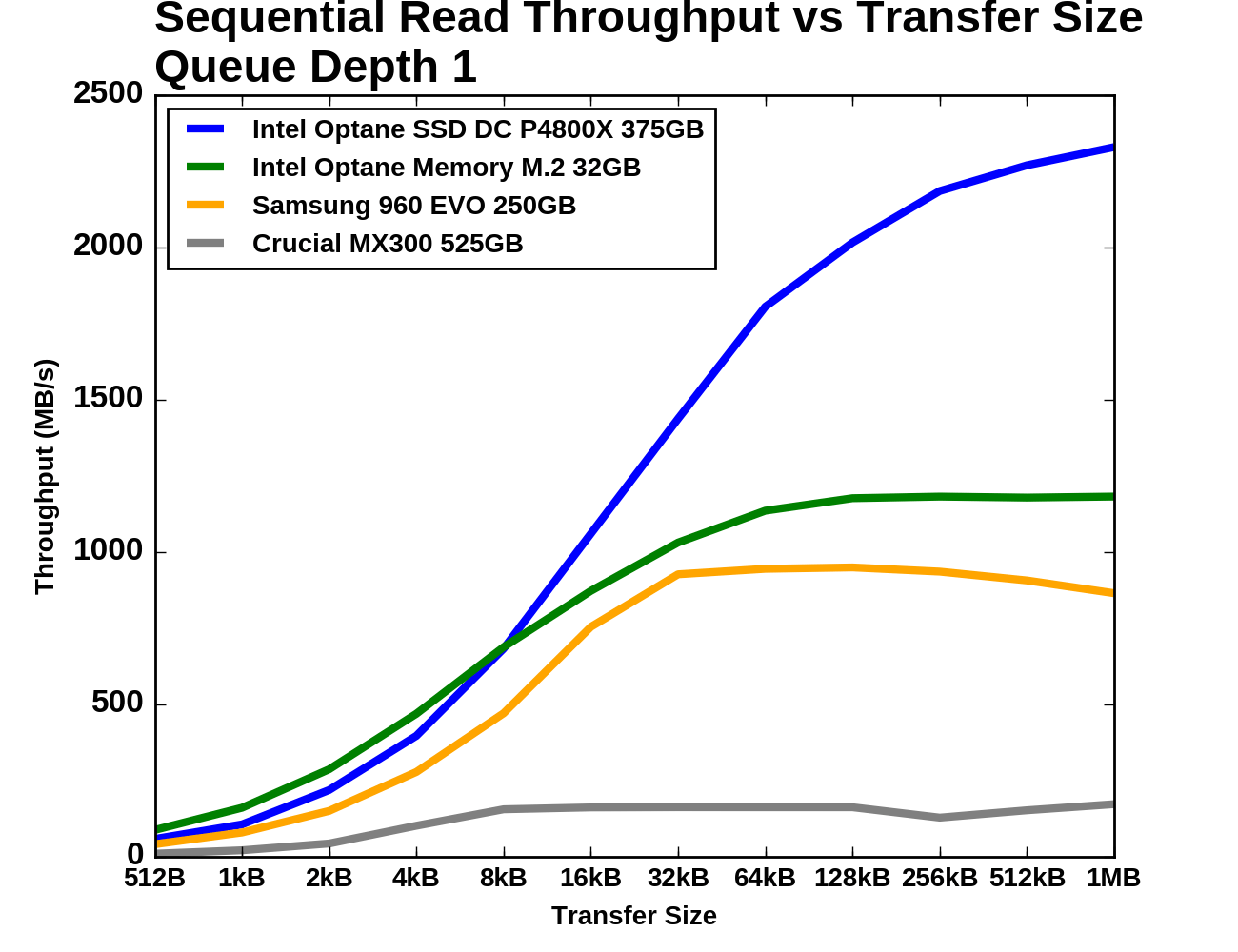 |
|||||||||
| Vertical Axis scale: | Linear | Logarithmic | |||||||
The three PCIe drives show similar growth through the small to mid transfer sizes, but the Optane Memory once again has the highest performance for small transfers and higher performance across the board than the Samsung 960 EVO.
Queue Depth > 1
For testing sequential read speeds at different queue depths, we use the same overall test structure as for random reads: total queue depths of up to 64 are tested using a maximum of four threads. Each thread is reading sequentially but from a different region of the drive, so the read commands the drive receives are not entirely sorted by logical block address.
The Samsung 960 EVO and Optane Memory start out with QD1 sequential read performance and latency that is relatively close, but then at higher queue depths the Optane Memory jumps up to a significantly higher throughput.
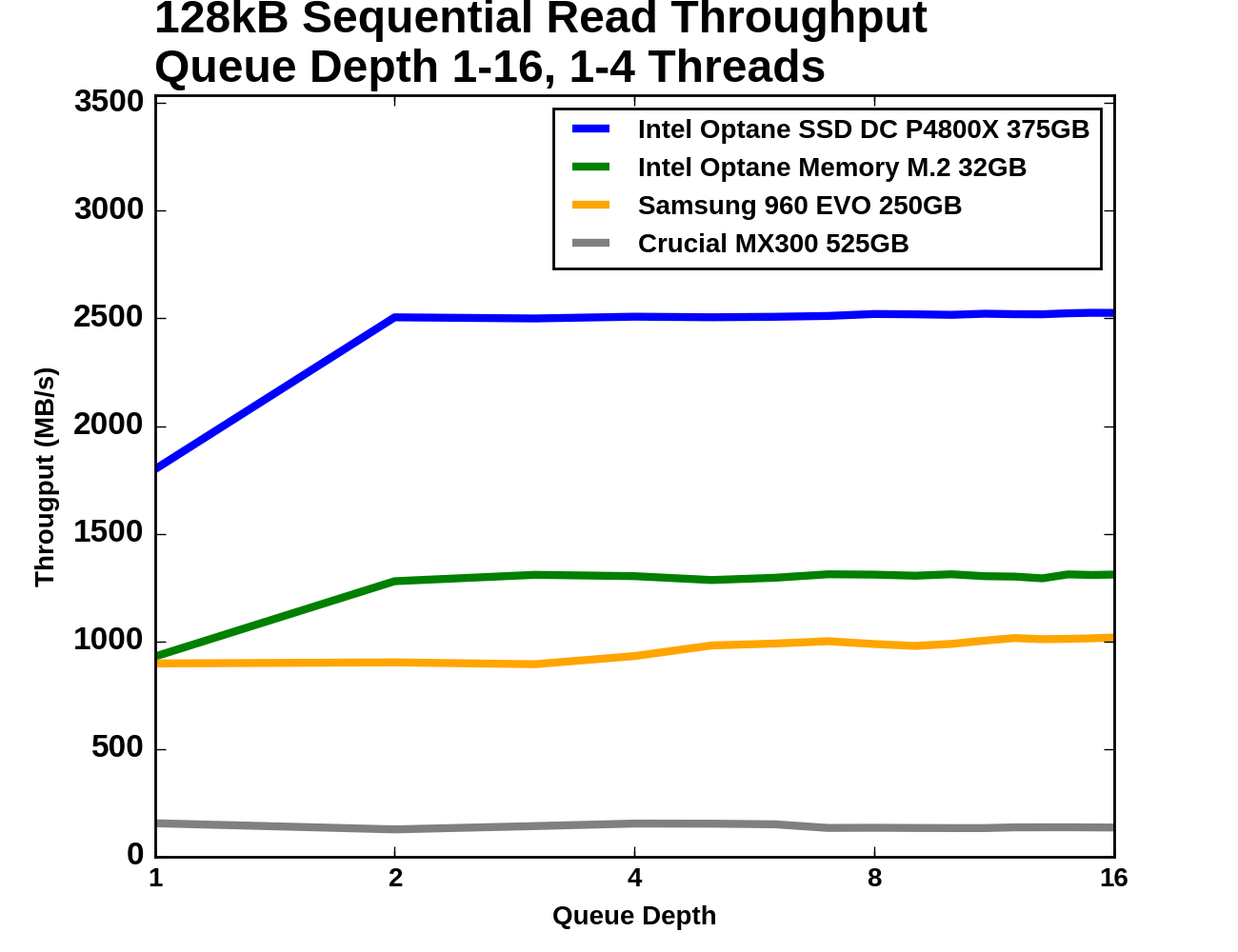 |
|||||||||
| Vertical Axis scale: | Linear | Logarithmic | |||||||
The two Optane devices saturate for sequential reads at QD2, but the Optane Memory experiences a much smaller jump from its QD1 throughput. The flash SSDs are mostly saturated from the start. The Crucial MX300 delivers far lower performance than SATA allows for, due to this test being multithreaded with up to four workers reading from different parts of the drive.
 |
|||||||||
| Mean | Median | 99th Percentile | 99.999th Percentile | ||||||
Since all four drives are saturated through almost all of this test, the latency graphs are fairly boring: increasing queue depth increases latency. For mean and median latency the Optane Memory and the Samsung 960 EVO are relatively close, but for the 99th and 99.999th percentile metrics the 960 EVO is mostly slower than the Optane Memory by about the same factor of two that the P4800X beats the Optane Memory by.
Sequential Write
The sequential write tests are structured identically to the sequential read tests save for the direction the data is flowing. The sequential write performance of different transfer sizes is conducted with a single thread operating at queue depth 1. For testing a range of queue depths, a 128kB transfer size is used and up to four worker threads are used, each writing sequentially but to different portions of the drive. Each sub-test (transfer size or queue depth) is run for four minutes and the performance statistics ignore the first minute. These tests were conducted on the Optane Memory as a standalone SSD, not in any caching configuration.
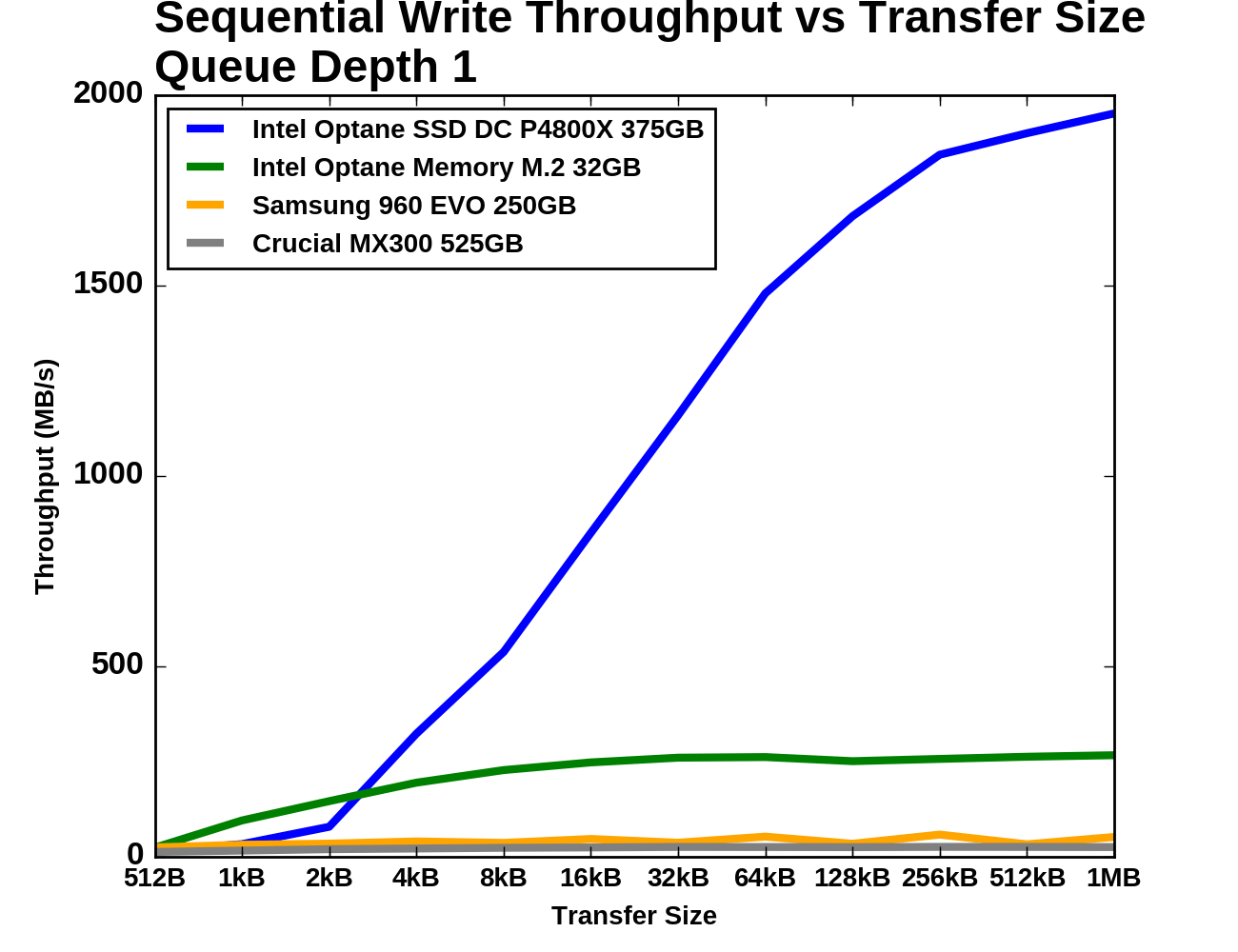 |
|||||||||
| Vertical Axis scale: | Linear | Logarithmic | |||||||
The enterprise-focused Optane SSD P4800X is slower than the consumer Optane Memory for sequential writes of less than 4kB, and even the Samsung 960 EVO beats the P4800X at 512B transfers. The 960 EVO's performance is inconsistent through the second half of the test but on average it is far closer to the MX300 than either Optane device. For larger transfers the MX300 is about a tenth the speed of the Optane Memory.
Queue Depth > 1
The sequential write throughput of the Optane SSD DC P4800X dwarfs that of the other three drives, even the Optane Memory. The Optane Memory does provide substantially higher throughput than the flash SSDs, but it does not have a latency advantage for sequential writes.
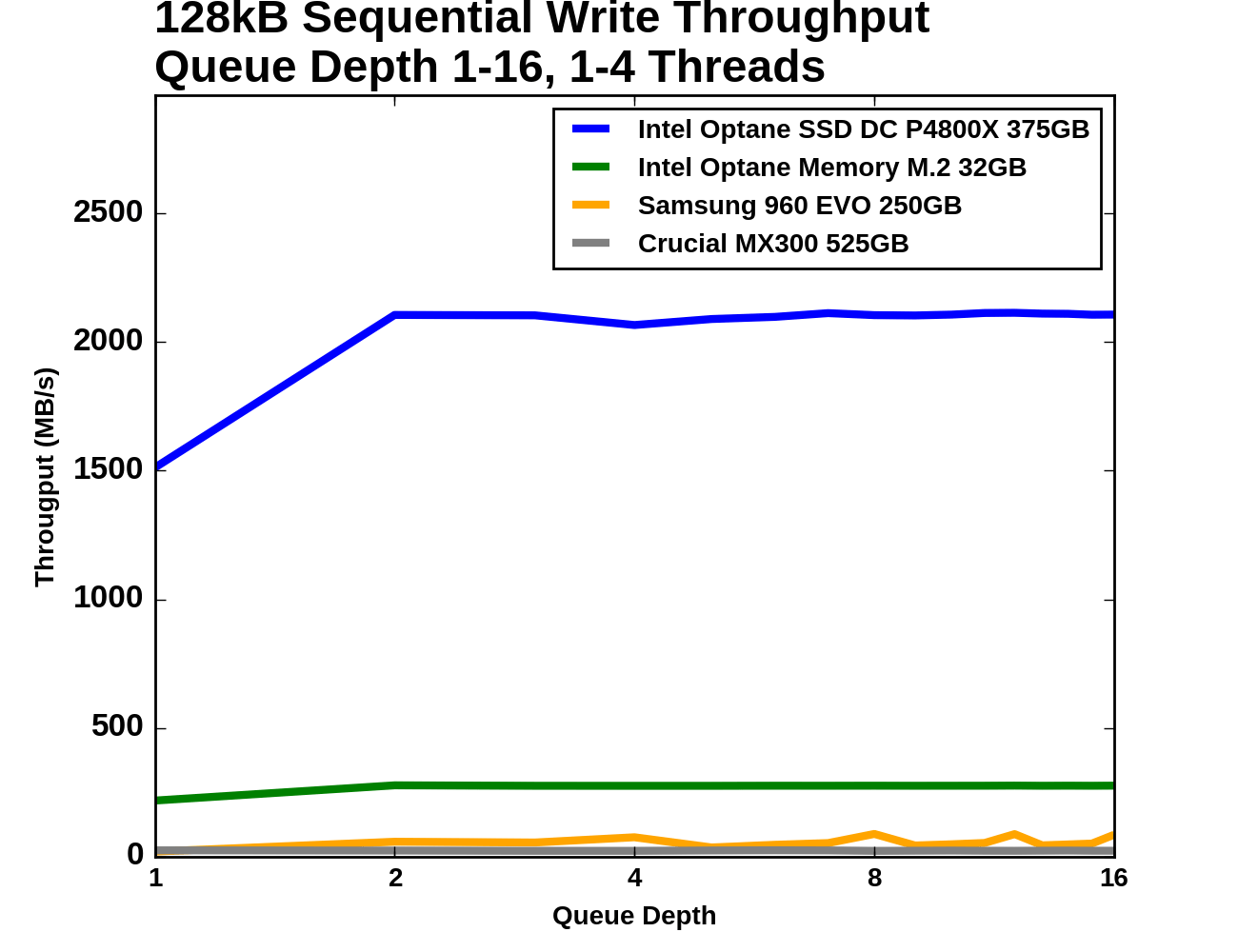 |
|||||||||
| Vertical Axis scale: | Linear | Logarithmic | |||||||
The Crucial MX300 is the only drive that does not get a throughput boost going from QD1 to QD2; as with the random write test it is not able to improve performance when the higher queue depth is due to multiple threads writing to the drive. The Samsung 960 EVO improves from the addition of a second thread but beyond that it simply gets more inconsistent. The Optane Memory and P4800X are both very consistent and saturated at QD2 after a moderate improvement from QD1.
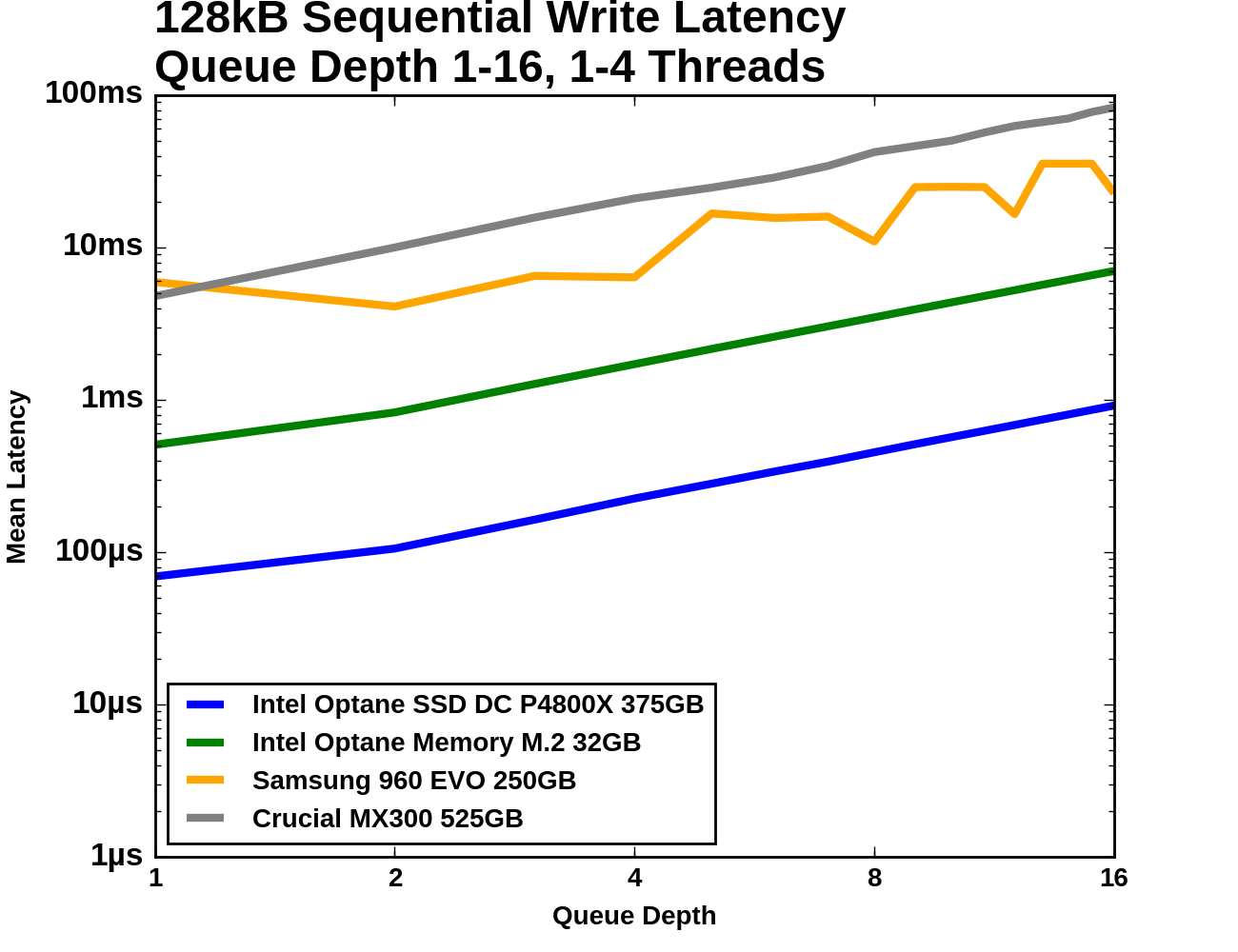 |
|||||||||
| Mean | Median | 99th Percentile | 99.999th Percentile | ||||||
The flash SSDs get more inconsistent with increased thread count and queue depth, but other than that the latency charts show the predictable growth in latency that comes from the drives all being saturated in terms of throughput.












110 Comments
View All Comments
ddriver - Wednesday, April 26, 2017 - link
It is only natural to have negative sentiments about greedy, lousy corporations because of what they do. It is nothing personal though, I do it because I am a conscious human being. Not cattle. You can throw crapple and moogle into the mix. There is no single good reason to be fond of any corporation. The bigger they are the more damage they do to humanity and the planet as a whole.In other news, water is wet!
eddman - Wednesday, April 26, 2017 - link
You are not fooling anyone.eddman - Wednesday, April 26, 2017 - link
...and you are so blind by your hatred that you dismiss every single thing that these companies do. You are not rational in the slightest but do like to boast about how great you are.Reflex - Tuesday, April 25, 2017 - link
Nailed it eddman. Because it does not personally solve ddriver's problems, or because it comes from the wrong brand, its an epic disaster. The funny thing here is I agree this is not a revolution, at least not yet, but the incessant bashing and inability to acknowledge that it has its uses and those use cases are likely to only grow demonstrates the bias involved.Reflex - Tuesday, April 25, 2017 - link
To the insinuation that Optane may somehow be relabeled SLC NAND, I went and did a little research/consultation. All NAND requires writing to blocks, Optane can support bit level writes (expected in DIMM configurations), which is a major advantage over NAND and not technically possible with NAND. It was also pointed out that if Optane was simply disguised SLC, despite the technical impossibility, it would mean that Intel had engaged in financial fraud by materially misrepresenting its technology, capabilities and long-term expectations to investors.Thanks to Joel Hruska for looking into it for me.
More info here: https://arstechnica.com/gadgets/2017/04/intel-opta...
More from Joel here: https://www.extremetech.com/author/jhruska
Reflex - Monday, April 24, 2017 - link
OMG it's the fastest product on the market in its class but because I choose to interpret the early marketing as applying to the first gen product it totally sucks! I refuse to benefit from drastically better performance because Intel *dared* to speak to its potential performance and didn't deliver that in the first product!In fact, I am so enraged I'm ripping out all my existing SSD's and replacing them with Quantum Bigfoot drives in protest.
Drumsticks - Monday, April 24, 2017 - link
It's probably because Intel dared to do something innovative again, and we can't possibly give credit where it's due, can we? If it was Samsung, I bet it would just be Samsung being Samsung. Slap the blue name on top, and it's cool to criticize whatever you can, even in the face of hard numbers. Make sure you also include an edgy name like "Hypetane" to really drive your point home.Reflex - Monday, April 24, 2017 - link
To be fair if it were Samsung we'd get a lecture on the oppression of North Korea mixed in there somewhere along with a conspiracy theory about the south being a puppet state not permitted to succeed in the face of America.jabbadap - Monday, April 24, 2017 - link
Well I don't want to degrade intel's efforts on this. But it's intel/micron co-operation who have engineered this and I would even guess a bit further that science behind this is more micron tech than intels.Drumsticks - Monday, April 24, 2017 - link
That's fair, and Micron definitely deserves credit as well. I'm sure they'll get their own when QuantX comes out, hopefully sometime this year. I suspect that the R&D was split very evenly, though; Intel has always been good at doing things "well" in the fab; Micron had excelled at doing them "cheaply" which is one reason the venture was reasonably successful. Plus, I feel it would be hard to collaborate on R&D together for 10 years and successfully say "we did this together" to the public, if one side (Micron or Intel) did most of the work. I guess we'll never know, though.